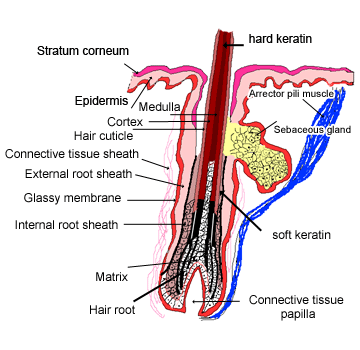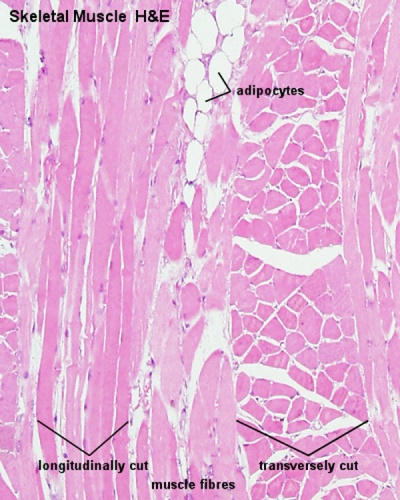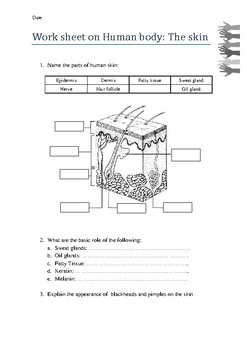45 label the structure of the skin
Simple Cuboidal Epithelium Function & Location | What Is Simple ... The simple structure in the lining of the bronchioles greatly helps in the respiration process. True | False 7. Both internal and external organs of the body contain a simple cuboidal epithelium. An Introduction to the 5 Layers of Abdominal Wall - New Health Advisor Skin; It will depend on the location whether different layers are absent or present. 1. Peritoneum. Made up of two different layers, the peritoneum has one layer that positions itself in the cavity of the abdomen while the other one lines the area around the organs. Besides supporting the organs that are in the abdomen, the peritoneum lets the ...
Structure of the Skin: Epidermis, Dermis, Hyperdermis, Cross ... - EMBIBE Structure of the Skin: Skin is the largest organ of our body that forms the protective covering of our body. It serves as a barrier between our body organs and the external environment. Beyond providing protection, it plays a crucial role in regulating body temperature. It possesses thermoreceptors and thereby serves as a sense organ.
Label the structure of the skin
Human Biology Lab Online | Lab 4 Tissues and Skin Select the Labels "On" button Use the slider bars on the side and bottom to scan around the slide. View the tissue at 1000x to see the fine ultra structure Note: Browser Pop-up Blockers must be turn off to view these slides. Click on any of the slides listed above on the tissue slide box image to view. The Skin: 7 Most Important Layers, Functions & Thickness The skin is the largest organ in the body and it covers the body's entire external surface. It is made up of seven layers ( [starting from the top layer down to the bottom [deepest] layer): Stratum corneum Stratum lucidum Stratum granulosum Stratum spinosum Stratum basale Dermis Hypodermis Histology, Skin - StatPearls - NCBI Bookshelf There are three main layers of skin: the epidermis, the dermis, and the hypodermis (subcutaneous fat). The focus of this topic is on the epidermal and dermal layers of skin. Skin appendages such as sweat glands, hair follicles, and sebaceous glands are reviewed in-depth elsewhere. [1] Structure
Label the structure of the skin. Epidermis: Definition, Structure, Function, and Examples Epidermis Structure. The epidermis, dermis and hypodermis are the three layers of skin. Epidermis is made from keratinized stratified squamous epithelium, where squamous are thin in structure and possess scales, whereas stratified consist of a thick layer. The epidermal cell's major element is the keratinocytes which results in the keratin ... Skin Structure And Functions Test 1 - ProProfs Quiz Underlying or inner layer of the skin it is also called the derma, corium, cutis, or true skin A. Stratum corneum B. Dermis C. Cuticle layer 5. Outer layer of the dermis directly beneath the epidermis A. Middle dermis B. Fatty layer C. Papillary layer 6. Produce dark skin pigment called melanin A. Melanotosis B. Melanocytes C. Melanin cells 7. The Integumentary System: Your Skin, Hair, Nails, and Glands The skin is made up of a very tough type of protein called keratin that is the primary type of skin in the outermost layer, the epidermis. Keratin helps protect tissues, organs, and structures from injury, like: Cuts Scratches Abrasions Fatty Layer Protection Integumentary System - Innerbody Hair also insulates the body by trapping warm air around the skin. The structure of hair can be broken down into 3 major parts: the follicle, root, and shaft. The hair follicle is a depression of epidermal cells deep into the dermis. Stem cells in the follicle reproduce to form the keratinocytes that eventually form the hair while melanocytes ...
Skin PS Brands - 628396 - 04/13/2022 | FDA For the gradual fading of dark (brownish) discolorations in the skin such as freckles, age and liver spots, . . ." [from your Drug Facts panel on your Dark Spot Fix product label] Structure & Function of Your Skin - American Osteopathic College of ... Skin is a waterproof, flexible, but tough protective covering for your body. Normally the surface is smooth, punctuated only with hair and pores for sweat. A cross-section of skin shows the major parts. It is divided into three layers. The outer layer is the epidermis. The dermis is in the middle and fat forms the innermost layer. The subcutaneous layer: Anatomy, composition, and functions The skin consists of layers called the epidermis, dermis, and hypodermis. The epidermis is the outermost layer, and the hypodermis, or subcutaneous layer, is the innermost layer. The subcutaneous... Summary of Cosmetics Labeling Requirements | FDA Off-package ingredient labeling is permitted if the cosmetic is held in tightly compartmented trays or racks, it is not enclosed in a folding carton, and the package surface area is less than 12 ...
Skin: Structure and function explained - Medical News Today The skin has three basic layers — the epidermis, the dermis, and the hypodermis. Epidermis The epidermis is the outermost layer. It is a waterproof barrier that gives skin its tone. It's main roles... Understanding The Different Layers Of Skin - SkinKraft Skin is the largest organ in your body and acts as a protective barrier. It is a connective tissue that consists of cells, fibres and extracellular matrix [ 1 ]. The three main layers in it are: Epidermis Dermis Hypodermis Functions Of The Skin's Layers 1. Epidermis 8 Essential Skin Functions | New Health Advisor Human skin is made up of three layers, the top layer (epidermis), beneath that you have the subcutaneous layer, and then the dermis. The skin, like most organs, is vital to overall health and it carries out many functions that help us and protect our health. Integumentary system: Definition, diagram and function - Kenhub Broadly speaking, the integumentary system is composed of skin and its appendages, subcutaneous tissue, deep fascia, mucocutaneous junctions, and breasts. This article will discuss all of these components in detail together with some clinical notes about them and the integumentary system as a whole. Contents Components Skin Functions Layers
Areolar Tissue: Definition, Functions, Structure & Location Its functions of areolar tissue are as follows: Areolar tissue supports the internal organs. Such tissue assists in the repair of tissues of muscles and skin also. Areolar tissue helps in packaging between the organs by filling the space inside the organs. Therefore, now we can delve into the structure of the tissue.
General Anatomy and Physiology of a Human: TEAS Tissues: A group of cells with similar structure that join together to perform a specialized function. Epithelial tissue: Also referred to as epithelium, it is the type of tissue that skin and glands are made of. Connective tissue: The type of tissue that ligaments, tendons and bones are made of.
The Hair Structure - Hair Guide - Philip Kingsley It is made of a protein called keratin, compacted and fused together. Keratin is the same material that nails, hoofs, feathers and claws are composed of. Keratin is a remarkably strong protein, very resistant to wear and tear. It is held together by two kinds of bonds: disulphide bonds and hydrogen bonds. Disulphide bonds are extremely durable.
art-labeling activity: basic anatomy of the skin The skin and its. The pinkish hue of individuals with fair skin is the result of the crimson color of oxygenated hemoglobin. Basic anatomy of the skin Part A Drag the appropriate labels to their respective targets. Free nerve endings subcutaneous layer oil gland dermis epidermis sweat gland sensory receptor adipose tissue sweat pore nerve.
Biopsy-free in vivo virtual histology of skin using deep learning We show that this trained neural network can be used to rapidly perform virtual histology of in vivo, label-free RCM images of normal skin structure, basal cell carcinoma, and melanocytic nevi ...
A Human Body Skin-structure Quiz! - ProProfs Quiz A Human Body Skin-structure Quiz! In this, a human body skin structure quiz, we are going to focus on the underlying and the most elementary structure of the human body. It's easy to take your skin for granted, but when you consider how it protects your body from harm, it is something we should appreciate more.
Skin: Cells, layers and histological features | Kenhub There are three general layers of the skin, and from superficial to deep, they are the epidermis, dermis and hypodermis. Each layer can be further subdivided into their own constituent regions. Epidermis Layers of the epidermis. Stain: H&E. Medium magnification. The epidermis is the uppermost layer of the skin.
Skin Anatomy: The Layers of Skin and Their Functions The skin is the body's largest organ. It is made of three layers, each of which has specific functions. The outermost epidermis is responsible for producing new skin cells, protecting the body from unwanted substances, and retaining moisture to keep the skin well hydrated. The middle dermis is responsible for supporting and strengthening the skin.
Understanding The Role Of The Hypodermis Layer Of Your Skin Connects Skin To The Bones And Muscles. The hypodermis helps attach the dermis and epidermis layers of the skin with the underlying bones and muscles. It also supports the skin layer with nerves and blood vessels. 4. Regulates Body Temperature. The hypodermis functions as an insulator. It protects the body from cold and heat.





Post a Comment for "45 label the structure of the skin"